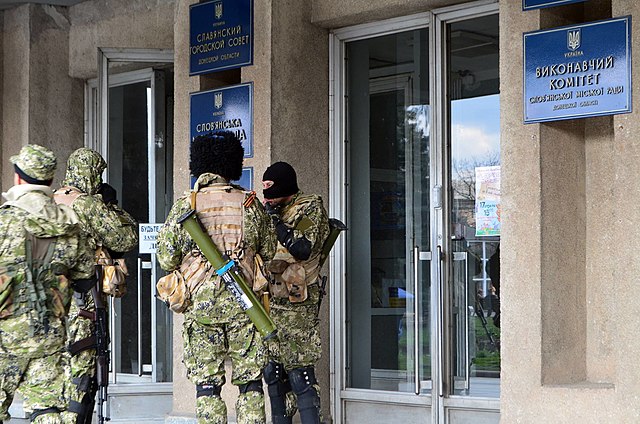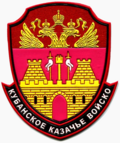Top Qs
Timeline
Chat
Perspective
Registered Cossacks of the Russian Federation
Russian ethnic paramilitary society From Wikipedia, the free encyclopedia
Remove ads
The Registered Cossacks of the Russian Federation are a paramilitary formation that originally performed non-military and public safety services, on the basis of the Federal Law of the Russian Federation dated December 5, 2005 No. 154-FZ "On State Service of the Russian Cossacks".[1] However, since the 2008 Russian invasion of Georgia, the Registered Cossacks have assumed a direct military role. [2] Despite their name, "Registered Cossacks" are not the traditional "Cossacks" of the Russian empire, which were destroyed by the Soviet Union, but instead a modern romanticist and Russophile re-creation of what the Russian state believes Cossack culture to have been, that originated as Pro-Russian militias in the North Caucasus.[3]
Remove ads
Background
Summarize
Perspective
Historically, Cossacks were a semi-nomadic and semi-militarized people, who, while under the nominal suzerainty of various Eastern European states at the time, were allowed a great degree of self-governance in exchange for military service. Although numerous linguistic and religious groups came together to form the Cossacks, most of them coalesced and became East Slavic–speaking Orthodox Christians.[4] Starting with the Russian Revolution of 1905 Cossacks became increasingly used by Tsarist officials for internal security due to their perception of not being tainted by revolutionary ideals, unlike the average Russian foot-soldier.[5] The Russian Army Command centralized and modernized Cossack institutions and placed them firmly under the command of the Monarchy, however, these institutions became resentful due to over-conscription and lack of compensation for the heavy Cossack presence in the Russo-Japanese war.[6]
When the February Revolution began Cossack troops notably deserted from tsarists ranks, and the Russian Provisional Government gave the Cossacks autonomy to self-govern themselves through assemblies called krugs or radas led by an Ataman. These Cossack autonomies refused to recognize the new Bolshevik government after the October Revolution and became de-facto independent in the form of the Don Republic and the Kuban People's Republic that nominally sided with the White movement to fight the Bolsheviks and preserve their autonomy.[7][8][9] A significant number of Cossacks also fought for the Bolsheviks as so called "Red Cossacks", however, the Soviet Union underwent an official policy of "De-Cossackization" from 1919 to 1933 to destroy the Cossack way of life due to their leadership's support for the whites.[10][11] Thousands of Cossacks where killed, their institutions destroyed, and their remaining people either deported and or forcefully integrated into the "Russian" identity over the subsequent decades.[12]
Thousands of Cossacks would flee Russia during and immediately after the civil war as émigrés living in Bulgaria, Czechoslovakia, Yugoslavia, and France. This also included the entire Transbaikal Cossack Host whose Ataman Grigory Semyonov was able to flee to Japanese controlled Manchukuo and assisted the Kwantung Army.[13] During World War II, as with other White Russian émigrés, Cossack leaders and officers would be recruited by Nazi Germany to serve as auxiliaries in their fight against the Soviet Union. The Germans organized the 1st SS Cossack Cavalry Division to consist of these émigrés as well as Cossack POWs. Starting in 1943 the German government continually promised that they would create an independent "Cossack Central Administration" led by Pyotr Krasnov, former Ataman of the Don Republic.[14] At the end of the war these Cossack units would fight towards Western Allied lines, and surrendered to British forces, in order to avoid looming death sentences in Russia. This resulted in the "Betrayal of the Cossacks" where the British repatriated all Cossack POWs, who would go on to be executed or sentenced to hard labor, including the mass execution of the 2,479 Cossack POWs at Lienz.[15]
Despite this the remaining Cossack diaspora would continue to call for an independent "Cossack Nation" throughout the Cold War, with Nikolai Nazarenko becoming a leading figure as the President of the "World Federation of the Cossack National Liberation Movement of Cossackia" a New York based pressure and cultural group for Cossacks, that called for an independent Cossack state dubbed "Cossackia" which they argued was a "captive nation." Time, however, was not on the exiled Cossacks side, as with each generation that passed the Cossack identity was further suppressed in Russia until it was all but destroyed, existing only in fringe exile organizations across the west led by increasingly aged elders.[16]
Cossack revivalism
During the collapse of the Soviet Union in the late 80s and early 90s, thousands of Russian-speaking Orthodox Slavs in border regions, especially the North Caucasus, sought to revive a Cossack identity. Although these "Cossacks" and their institutions bare no continuity with the historical Cossack hosts these Cossack-revivalists "re-created" many historic Cossack "circles", crowned "atamans", and even attempted to form pro-Russian secessionists efforts in independence seeking nations, like Checnya. In 1992 11 of these revived circles met on the issue of prospective independence and support for Nazarenko's proposal of an independent "Cossackia", however, all 11 of them rejected the proposal and instead called for a "United Russia." A growing and militant paramilitary supportive of Russian Neo-Imperalistic ambitions across the Caucasus and Eastern Europe, the Russian government quickly sought to subordinate these "circles" first in 1995 and 1997 via Presidential decrees, and again in 2005 through an official law that passed through the Duma.[17]
Remove ads
History
Summarize
Perspective
There reportedly are up to 10 million Cossacks in Russia, and the registered Cossack associations include around 740,000 people, of whom around 600,000 also carry out border and security tasks.[citation needed] However, in the 2010 Russian census, only about 67,000 people described themselves as Cossacks.[18]
Cossack units have also been raised for and existing Cossack units have been placed under the control of the National Guard of Russia.[19]
Registered Cossacks in military service
Cossack units helped in the Russian operations in Abkhazia, South Ossetia, and Transnistria.[2]
2008 Russian invasion of Georgia
Cossacks also took an active role in the 2008 Russian–Georgian war during which no one could explain what role the Cossacks played in the campaign, as Russian soldiers were distinguished between regular servicemen and Cossacks.[2]
Russo-Ukrainian War

2014
Various Registered Cossacks of the Russian Federation were identified operating in Eastern Ukraine and Crimea in 2014 during the Russo-Ukrainian War with Kuban Cossacks helping occupy the Crimea and Don Cossacks invading the Donbas. Cossack units were organized communities not as spontaneous volunteers.[3]
2022
Registered Cossacks are heavily involved in the 2022 Russian invasion of Ukraine[20] where they are part of 18 ‘Cossack’ BARS (Combat Reserve Forces) battalions taking part in the invasion.[20][21][22] Per Ataman Nikolai Doluda, head of the All-Russian Cossack Society,"There are three battalions each from the Kuban and Terek hosts, two from Don, one from Orenburg, a Orenburg-Volga combined battalion, one from the Ussuriskiy host, one from the Zabaykalsky host, and one from the union of “Cossack” warriors from abroad"[21] Various sources number Registered Cossacks in the warzone to from 15,000 [23] to 25,000.[20][24]
Remove ads
Duties
Summarize
Perspective
In peacetime, the registered Cossacks are used for the following activities and functions: conservation, protection and restoration of forests; patriotic education of young people and their preparation for military service; Assistance in natural disasters, accidents, catastrophes and other emergencies; extinguishing forest fires and other fires; protection of public order; Border protection and securing the state border; Protection in municipalities and in municipal institutions and organizations; In some regions, the operation of a city police force (including special units “Kobra”), in which numerous Cossacks ensure public safety.

Registered Cossacks perform a substitute function on behalf of the Ministry of Internal Affairs and the Ministry of Emergency Situations. In this way, they compensate for the lack of trained personnel in the country's security structures and, through their voluntary work, they contribute to savings for the state budget.[25][3]
Registered Cossacks receive a stipend[25] and are granted certain privileges: a uniform, a rank, insignia and awards, wearing a Cossack whip (nagaika), sword (shashka), dagger (Qama) and, in certain cases, firearms or a firearms permit in exchange for providing security in certain areas.[25] Registered Cossacks often wear uniforms of the Russian army or uniforms similar to that of the Imperial Russian Army.[25]
All-Russian Cossack Society

The All-Russian Cossack Society (Russian: Всероссийское казачье общество, Latinized: Vserossiyskoye kazach'ye obshchestvo) is a government sponsored Cossack advocacy organization in the Russian Federation. It is responsible for the coordination of activities between the 12 registered Cossack hosts. In particular, it works in the spheres of patriotic education and the continuing historical Cossack customs and traditions. Both registered and non-registered Cossack organizations can be part of the society. It is headed by the Society Ataman, Cossack General Nikolai Doluda.
Cossack ranks from yesaul and above are appointed by a Presidential Envoy, the rank of a Cossack general by no less than the President of the Russian Federation. All other ranks are promoted by their respective troop commandants.
Remove ads
Organizations
Summarize
Perspective
Cossack hosts
The Russian Federation has twelve Cossack hosts officially recognized by the federal government; these being the Don, Kuban, Terek, Orenburg, Volga, Siberian, Yenisei, Zabaykalsky, Irkutsk, and Far Eastern; all formed in the 1990's.[26] The Central Cossack host, including Moscow, was created in 2007 while the Black Sea Cossack host, including the Crimea, was added in 2015.[23] These officially recognized hosts may or may not be the same as the historical hosts.[26]
Note that under the new uniform regulations the open collar tunic, worn with a shirt and tie, has been replaced by a tunic with a standing collar.
Independent Districts
In addition to the military Cossack Hosts, there are other registered societies which are active auxiliaries:
Current
- Separate Northwest Cossack District (Territory of activity - Northwestern Federal District). Headquarters - St. Petersburg;
- District Cossack society "Baltic separate Cossack District - Baltic Cossack Union" (Territory of activity - the Kaliningrad region). Headquarters - Kaliningrad;
Former
- District Cossack society "Sevastopol Cossack District '(Territory of activity - Sevastopol). Headquarters - Sevastopol.
- Crimean Cossack District Society "Crimean Cossack troops" (Territory of activity, Republic of Crimea),. Headquarters - Simferopol.
Both of the above last two were integrated into the Black Sea Cossack host in 2015.
Remove ads
Cossack ranks and insignia
Summarize
Perspective
- Officers
The rank insignia of commissioned officers.
- Other ranks
The rank insignia of non-commissioned officers and enlisted personnel.
Remove ads
See also
References
Wikiwand - on
Seamless Wikipedia browsing. On steroids.
Remove ads


























































